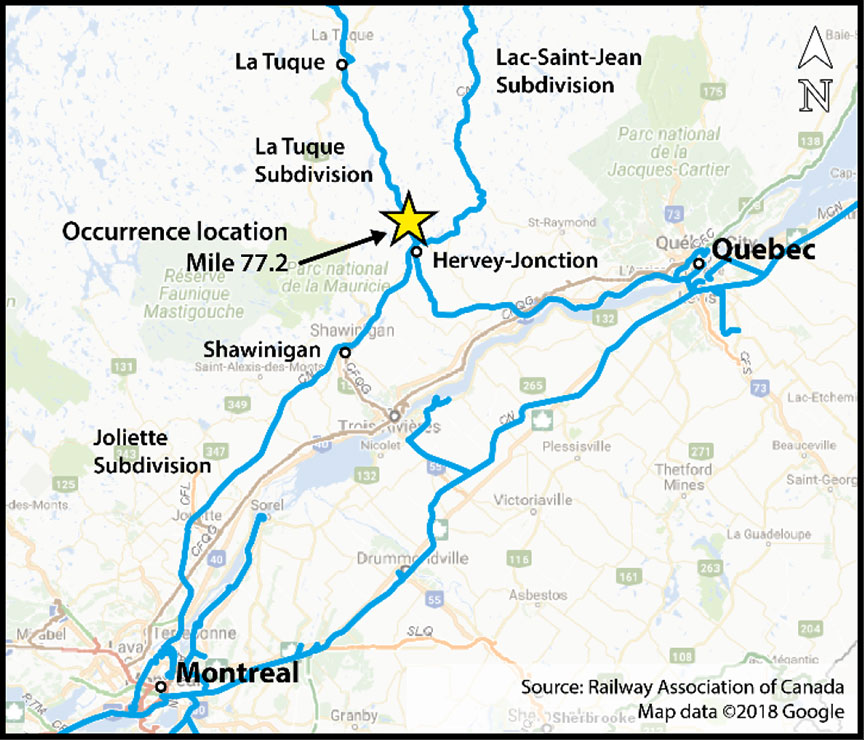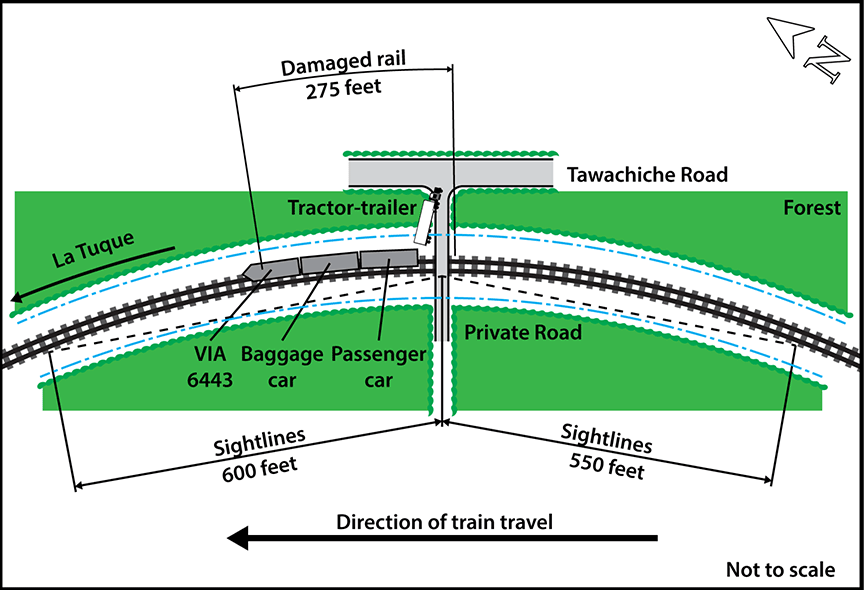Crossing collision
VIA Rail Canada Inc.
Passenger train P60321-25
Mile 77.2, Canadian National Railway Company La Tuque Subdivision
Hervey-Jonction, Quebec
The Transportation Safety Board of Canada (TSB) investigated this occurrence for the purpose of advancing transportation safety. It is not the function of the Board to assign fault or determine civil or criminal liability. This report is not created for use in the context of legal, disciplinary or other proceedings. See Ownership and use of content. Masculine pronouns and position titles may be used to signify all genders to comply with the Canadian Transportation Accident Investigation and Safety Board Act (S.C. 1989, c. 3).
The occurrence
On 25 October 2017, at approximately 1215,Footnote 1 VIA Rail Canada Inc. passenger train P60321-25 (the train), with 8 passengers on board, left Hervey Station, Quebec, bound for Senneterre, Quebec. The train consisted of locomotive VIA 6443, a baggage car and a coach. It weighed about 250 tons and measured 225 feet in length. The train crew comprised an operating locomotive engineer (OLE) and an in-charge locomotive engineer (ICLE). Both were qualified for their respective positions, met rest and fitness standards, and were familiar with the territory.
At about 1230, the train was travelling west at a speed of 39 mph and was approaching a private crossing located at Mile 77.2 of the Canadian National Railway Company (CN) La Tuque Subdivision (Figure 1). The locomotive headlights and ditch lights were at full power. Given that the crossing was private, the train was not required to whistle at its approach. When the train was approximately 550 feet east of the crossing, the OLE noticed that a tractor-trailer (truck) loaded with logs was occupying the crossing. The OLE immediately applied the emergency brakes and activated the whistle and bell. The train could not stop before the crossing and struck the back of the trailer about 9 seconds later.
After the train came to a complete stop, the crew broadcast a radio emergency call, as required by the applicable regulations. The on-board service manager took charge of the passengers. None of them were injured. The passengers were driven to their destination by taxi. As a precautionary measure, 2 passengers were examined at the hospital. The truck driver sustained minor injuries and was transported to hospital.
At the time of the accident, the temperature was 6 °C with cloudy skies.
Site examination
The accident occurred at a private crossing that leads to a maple sugar and logging site, about 6 miles west of the Hervey Station. A gravel road gives access to the crossing and crosses the railway tracks at 90 degrees.
The private crossing is located about 1000 feet from the entrance of a 4 ° left-hand curve for westbound trains. That curve extends approximately 1870 feet. The crossing has passive protection on both sides of the track consisting of a stop sign and a private crossing sign.
As a result of the accident, the post supporting the signs on the north side of the track was torn off and the wood planking was damaged.
The rolling stock derailed upright and remained coupled together. The locomotive came to rest approximately 260 feet west of the crossing. It sustained damage to the front of the cab, to the right ditch light and couplings as well as to the locomotive pilot. The baggage car and coach sustained some damage. The rear of the coach came to rest about 30 feet west of the crossing.
The truck had been pushed in the ditch and was on its left side, perpendicular to the track, in the northwest quadrant of the crossing (Figure 2).
The load of logs rolled over and the trailer was twisted. Approximately 200 litres of diesel spilled from the truck's fuel tank.Footnote 2
Grooves were visible on the ties starting about 20 feet east of the crossing and extending to the west along the track up to the front wheels of the locomotive. The ties were grooved and some of them were destroyed. The derailed wheels travelled over the tie plates and anchors at the gauge side of the south rail for a distance of about 275 feet. The north rail was rolled out and wheel marks were observed along the web extending west up to the front of the locomotive. Approximately 250 feet of rail had to be replaced.
Subdivision and track information
The CN La Tuque Subdivision is a single main track that extends from Cap-Rouge, Quebec (Mile 0.0), to Fitzpatrick, Quebec (Mile 125.4). Train movements are controlled by the occupancy control system as authorized by the Canadian Rail Operating Rules, and are supervised by a CN rail traffic controller located in Montréal, Quebec.
In the accident area, train traffic consisted of 2 freight trains and 1 passenger train per day. The track was rated as Class 3, according to the Transport Canada–approved Rules Respecting Track Safety, also known as the Track Safety Rules (TSR). The authorized speed in the area was 35 mph for freight trains and 40 mph for passenger trains.
The track structure consisted of 115-pound continuous welded rail manufactured by Algoma in 1973. The rail was set into double-shouldered tie plates, secured with 4 spikes per plate and box-anchored every other tie. The ballast consisted of crushed rock. The inspections had been completed according to the TSR provisions. The last track visual inspection, which had been completed on 24 October 2017, had identified no defects.
Driver and tractor-trailer information
The truck driver met rest and fitness standards and the requirements for his position. He had about 35 years of experience in driving heavy trucks.Footnote 3 He was employed by a trucking company. He normally worked between 10 and 11 hours per day, from Monday to Thursday, and 7 hours on Friday, finishing work around noon. At the time of the accident, he had been working since approximately 0500, and was in the process of delivering his third load of the day. He had been loading logs at the logging site just south of the crossing for about 1 week and had used that crossing 4 times previously. He knew that the railway was in service, but had not seen any trains go by at that crossing in the past week.
The truck consisted of an International 2011 tractor and of a Manac 2014 log trailer. The tractor-trailer measured about 65 feet and had a gross weight of approximately 100 000 pounds. The truck and trailer were plated in the province of Quebec and their last preventative maintenance had been completed in August 2017 and July 2017 respectively. All observed defects had been corrected.
Taking into account the truck's characteristics, the truck required about 14 seconds to clear the distance from the stop sign to the crossing clearance point.Footnote 4
Sightlines
The sightlines at a crossing must allow users to have sufficient time to see a train approaching the crossing and react to it. For crossings equipped with a stop sign, sightlines are measured from the stop position. At the occurrence crossing, the sightline to the east from the south approach was about 550 feet. A passenger train travelling at 40 mph clears that distance in about 9 seconds. Therefore, even if a driver stops and notices that no train is approaching, a vehicle that cannot clear this crossing within 9 seconds could be struck by a train.
Private crossing
When the private crossing was first constructed, the crossing sightlines were based on a design vehicle corresponding to a heavy single unit (HSU) truck.Footnote 5 However, over the years, vegetation had grown in the vicinity of the crossing, affecting the sightlines. The crossing had not undergone a regulatory inspection within the previous 5 years.
In spring 2016, the landowner acquired the maple sugar and logging site, which included ownership of this crossing. About a week before the occurrence, tractor-trailers had started to transport logs from the site.
Action taken
On 25 October 2017, CN issued a temporary slow order of 25 mph for trains at the crossing. At that speed, given the existing sightlines to the east, a train would be in view for about 15 seconds before it occupies the crossing.
As a result of this occurrence, TC inspected the crossing and determined that the sightlines were insufficient to allow a heavy truck to clear the crossing safely. TC issued a notice on 20 November 2017 asking CN to resolve the situation. As of March 2018, the 25 mph slow order was still in effect at the crossing.
Following the occurrence, CN communicated with the owner of the crossing regarding the need for additional sightline distance and, in anticipation of the landowner's response, cleared the sightlines to accommodate the new vehicle type and current track speed.
Safety message
Since 2008, 226 accidents involving heavy trucks at passive crossings have occurred on federally regulated track in Canada. The time it takes to clear a crossing varies according to the vehicle type. Therefore, the adequacy of the sightlines at a crossing will be affected by the authorized maximum track operating speed and the time it takes a specific vehicle type to accelerate and travel over the crossing.
It is important that crossing-related information be shared with all stakeholders to ensure that appropriate safety measures can be implemented as required.
This concludes the TSB's limited-scope investigation into this occurrence. The Board authorized the release of this investigation report on . It was officially released on 26 March 2018.

